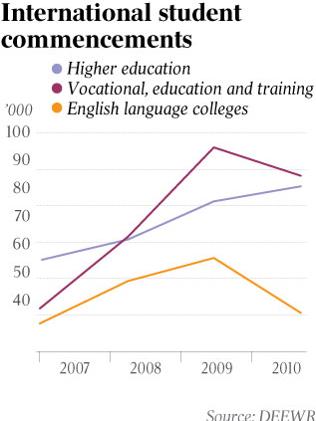1998 – Államszövetségi pénzből finanszírozott nemzetközi hirdetési kampány kezdődött az ausztrál oktatási szolgáltatások megismertetésére.
1998. aug. – 5 extra pont jár annak, aki Ausztráliában szerezte a végzettségét.
1999. március – Beindították a hiányszakmák listáját (MODL). Extra pontok jártak érte. Korábban is létezett ilyen, most csak újra elővették a módszert.
2001. július – Az első áttörés: Az Ausztráliában végzett külföldi diákok helyben pályázhattak állandó lakosi vízumra. Elég volt egy év ausztráliai tanulás ahhoz, hogy a helyben-pályázás jogát megszerezzék. Ekkor magyar közgázos végzettségűek simán megfeleltek, ha egy éves ausztrál business iskolát végeztek.
27 per cent increase in offshore student visa grants between 2001 and 2003. It also led to strong growth in demand for permanent migration from former overseas students who obtained qualifications in Australia, with former students comprising almost half of those granted independent skilled migration visas through the GSM. Due to the high demand for permanent migration from former students, the Government increased the pass mark for all skilled migration applications received after May 2002 from 110 to115 points.
2001 és 2003 között 27%-kal nőtt a külföldön kiosztott ausztrál diákvízumok száma. Korábban itt végzettek is megpróbálkoztak a visszatéréssel, mint állandó lakosok, hiszen járt nekik extra 5 pont. Hamarosan az egykori diákok tették ki a szakképzettségre alapozott bevándorlási létszám felét.
2002. május – a kormány kénytelen volt ponthatárt emelni, 110-ről 115-re.
2003. július – A bevándorláshoz szükséges ausztrál tanulmányi időt egy évről kettőre emelték.
2003. december – Rugalmasabb rendszert vezettek be a külföldi diákoktól elvárt anyagi háttér megítélésében. A magyar diákoknak elég volt bemutatni, hogy a szüleik rendelkeznek ingatlannal és ezzel meg is feleltek az anyagi követelményeknek.
A felsőfokú tanulmányok előtt alapozó angoltanfolyamokra is be lehetett iratkozni és ezzel meg lehetett szerezni a sok évre szóló diákvízumot egyetlen lépésben, minden angoltudás nélkül is.
Az itt végzett diákok és az itt dolgozó ideiglenes lakosok tették ki szakmai alapú bevándorlási létszám felét, aztán pedig több mint a felét.
2005. április – A ponthatárt 115-ről 120-ra emelték. Ezzel átléptek egy fontos határt: a hiányszakmák listáján lévő foglalkozások ezek után komoly előnyt élveztek, mert az esetek jó részében csak ezekkel lehetett elérni a 120 pontot. Az emelés előtt csak 9%, az emelés után egy évvel pedig 42% volt a hiányszakmás jelentkező.
2005. május – A második áttörés: a szakács- és a fodrász szakmákat is felvették a hiányszakmák közé. Megkezdődött a szakképzési szektor piramisjáték-jellegű növekedése.
Hamarosan világos lett, hogy ennyi képzettséggel nem lehet labdába rúgni az ausztrál munkaerőpiacon. Jobb angoltudás és szakmai gyakorlat is kellene. A kormány bevezetett egy ideiglenes lakos vízumot az itt végzett diákok számára, hogy ezt elérhetővé tegye számukra.
2001 óta a külföldi diákok száma évenként 13,9%-al növekedett. A 2008/09-es pénzügyi évben 320 368 diákvízumot adtak ki. (Ez az évi bevándorlási létszám kétszerese. Mi van, ha csak a felének sikerül itt maradni?)
Különösen gyorsan nőtt a szakképzésben részt vevő diákok száma. 2008/09-ben már igazi piramisjátékhoz illő emelkedés volt: 52,2%-os.
2009. augusztus – Az első megszorító intézkedések, egyelőre csak a durva csalások kiszűrésére: jobban ellenőrizték a diákok anyagi hátterét.
2010. február – Bejelentették a változtatási tervet: új szakma-lista lesz, új pontozás lesz, szakmánkénti létszámkorlátozás lesz. A diákoskodást és a bevándorlást szétválasztják.
The new SOL, released on 17 May 2010, contains 181 managerial, professional and trade occupations, but crucially removes occupations, such as hairdressing and cooking, which drove much of the growth in the VET sector in the previous five years. All applicants for independent skilled migration visas under the GSM must now have qualifications relevant to an occupation on the SOL.

Ez a statisztika a külföldi diákok beiratkozását mutatja. Jól érzékelhető a visszaesés. További drámai zuhanás várható, mert az angol nyelvi képzés a felsőfokú képzés bevezetője. {Ez a statisztika éppen csak eléri az igazi változtatásokat, mert azok 2010. július 1-től léptek életbe. Akkor jött ki az új Szakképzett Foglalkozások Jegyzéke, amin már nincs rajta a külföldi diákok körében legnépszerűbb szakács és fodrász szakma. Az iskolaügynökségek is ekkor hagyhattak fel a hirdetési kampánnyal.} kék - felsőfokú képzés bordó - szakképzés narancs - angol nyelv
2010. május 17. – Bejelentették az új szakma-listát (SOL). Fele akkora, mint a régi. A szakács- és a fodrász szakmákat levették róla. A piramis összeomlott. Az itt végzett diákok túlnyomó többségétől megvonták az itt maradás lehetőségét. Csak egy kis számú, szponzorált munkavállaló juthat letelepedéshez. Nyilván a legjobbak, akik értik a szakmát és nem csak a papírért és a vízumért tanultak.